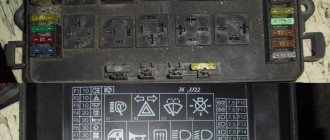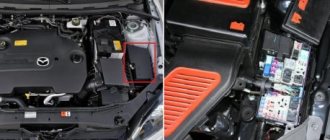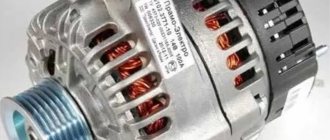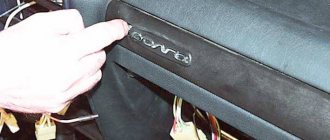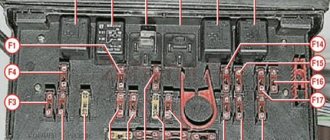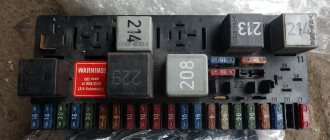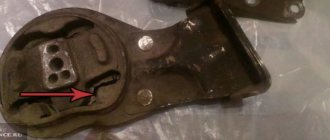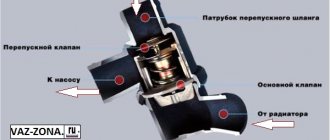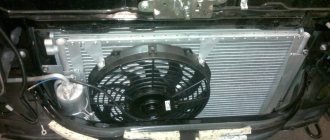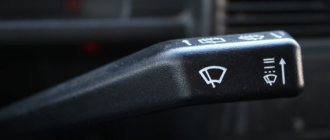Ignition relay VAZ 2107, 2105, 2104
An ignition relay is installed in the ignition system of VAZ 2107, 2105, 2104 cars.
Ignition relay for VAZ 2107, 2105, 2104 cars
— Purpose of the ignition relay
The ignition relay is designed to reduce the current flowing through the low-voltage part of the ignition system. This prevents burning of the ignition switch contacts and their premature failure.
Because of this, the ignition relay is also called a unloading relay.
— Where is the ignition relay located on a VAZ 2107, 2105, 2104?
The ignition relay on VAZ 2107, 2105, 2104 cars is installed under the instrument panel, next to the ignition switch, to which it is connected by wires.
— How does the ignition relay work?
The ignition relay for VAZ 2107, 2105, 2104 cars is electromagnetic. It consists of an electromagnet (core with a winding) and contacts that close when voltage is applied to it. The relay has four terminals. Relay input is contact “86”, output is “87”, constantly energized “30”, ground is “85”. From above, the entire system is closed by a housing. The body has a bracket (eyelet) for fastening.
Relay 113.3747-10 (ignition relay), device
— How does the ignition relay work for VAZ 2107, 2105, 2107?
When voltage is applied from terminal “15/1” of the ignition switch (turning the key) to terminal “86” of the relay, its electromagnet is activated, the moving and fixed contacts are closed inside, electric current begins to flow through them from terminal “30” to terminal “87” and then through the mounting block to terminal “B” (“C”) of the ignition coil (primary winding). The coil is charged and ready for use. The ignition relay contacts will be in the closed state while the ignition system is operating (ignition is on). This is a continuous relay. After de-energizing, the relay contacts open.
The easiest way to track the operation of the relay is using the ignition system diagram.
Diagram of the contactless ignition system for VAZ 2105, 2107. 2104
— Malfunction of the ignition relay
As a result of a short circuit or voltage surges in the vehicle's on-board circuit, the relay winding may burn out or its contacts may burn out. After which the car engine cannot be started (the starter turns, but the engine does not start). The easiest way to check the serviceability of the relay is to replace it with a similar one from the mounting block.
In some cases, you can try to revive a faulty relay by cleaning its contacts and setting a gap of 0.1 mm between them. But if the winding burns out, then the relay only needs to be replaced.
— Applicability of the ignition relay in the ignition system of VAZ 2107, 2105, 2104
The ignition system of the carburetor engine of VAZ 2107, 2105, 2104 cars uses an ignition relay 113.3747-10 with a mounting bracket. It is similar to relay 113.3747 (without bracket).
Source
Purpose and principle of operation of the relay
What is a relay and what is it for?
Relay is an electrical device (switch) designed to close and open various sections of electrical circuits for given changes in electrical or non-electrical input quantities.
Types of relays may differ in the control signal and in design, we will not dwell on this, especially since all this is on the same Wikipedia. We only note that electric (electromagnetic) relays are most widespread. to understand why a relay is needed from the definition, so let’s break it down in simple words: The relay is designed for switching large load currents. In other words, it is a switch, or even simpler - the principle of operation of a relay - with a small current (for example, a button signal) to turn on circuits with a large current. And a relay is used when the actuator (starter, generator, fan, heated mirrors, horn, etc.) consumes more current (up to 30-40 amperes).
FOR EXAMPLE: In order to start the engine with a small button, it is necessary to turn on the starter, which consumes from 80 to 300 amperes. If you do not use a relay, then the button will not withstand high current and will melt, as well as the wiring, which is not intended for high currents. Therefore, a connection is made through a relay (a relay is installed between the button and the starter), which, based on a small current impulse from the button, closes powerful contacts within itself, thereby turning on the starter. How does this happen ?
Relay device
Relay characteristics and manufacturers
Contacts and operating principle of the relay
Some types of relays
- relay with five contacts (5-pin relay). If a signal is applied to the winding, then contact 30 is disconnected from 87a and connected to 87.
- relay with four contacts (4-pin relay). Contact 87a or 87 may be absent, then the relay will only work to turn on or off (close or open) the power circuit.
All relays have coil contacts (pins 85 and 86).
Relay circuit example
Features and service life of the relay
Features of the relay If the diode icon is shown on the relay body, then when turning it on, it is necessary to observe the polarity on the control contacts.
Relay service life If the relay has been operated for a long time when switching power circuits in extreme modes, then the spark that jumps when closing or opening the contacts creates carbon deposits between the contacts and because of this, the actuator may not work or will not work correctly. Poor contact generates heat. At the same time, the current consumption in the power circuits may increase (if the contact is poor, the current of the electric motor or light bulb becomes a pulse-start), which entails heating of the places of poor contact in the switched circuits and, as a result, melting of the plastic parts for fastening the contacts. When fastening parts melt, the contacts shift and a sparking process is added, which further heats the contact point.
The VAZ relay of the tenth family is located in various places, for example in the mounting block, on the starter, etc. Standard diagrams of the VAZ 2110 can be found here. In the comments you can post useful diagrams using relays.
How often does a relay fail in your car?
Operating principle
The VAZ 2114 ignition relay is structurally similar in design to other electronic relays.
Its main purpose is to start the starter and, as a result, initiate the start of the engine itself. At the same time, the relay is responsible for other equally important tasks, for example, for protecting the starter from too high voltage or, on the contrary, for starting the engine when the battery is dead (thus, it corrects the voltage in the power circuit going to the starter) .
In addition, by breaking the electrical circuit after starting the engine, the main relay thereby protects the ignition switch contacts from burning or even melting.
Additional block
It is located under the center console and is covered with a lid. One part is accessible from the right side.
Scheme
Designation
- 15A - Ignition module, controller
- 15A - Canister purge valve, vehicle speed sensor, oxygen concentration sensor (heating), air flow sensor
- 15A - fuel pump, fuel pump fuse, injectors
- Electric fan relay
- Fuel pump relay
- Main relay (ignition relay)
The other part is on the left side of the console:
Scheme
Decoding
- Central locking control unit
- Immobilizer block
- Relay for turning on rear fog lights.
This is interesting: How to check the generator on a VAZ
Signs of a relay malfunction
Sure signs that the relay has failed may include:
All these factors, and especially their combination, directly indicate that the device is broken and should be replaced. But before you begin the repair, you should find out where the ignition relay is located on the VAZ 2114? You should look for this electronic element under the decorative trim-casing, to the left of the steering wheel. In order to gain access to the relay, this casing must be removed.
In some cases, you can try to remove the relay without removing the casing. This can be done by carefully placing your hand underneath the casing. True, this method requires a certain skill and an accurate understanding of the location and method of attaching the relay. For this reason, when replacing the device for the first time, it is recommended to dismantle the casing.
Another, although less rare, but still common problem is overheating of the ignition relay. So, if after a long trip (during which many consumers were turned on, the operation of which is controlled by this relay - windshield wipers, glass heaters) it became very hot, then you should immediately begin searching for the cause, without waiting for the device to burn out or other problems in the on-board network.
As a rule, the high heating of the main relay is due to its low amperage in combination with a large number of consumers (the standard model 14 ignition relay is designed for a current of 70 Amps). In order to check this, it is enough to disconnect a number of devices from the relay (with the exception of the starter, of course) and check its condition after the trip.
If the relay remains cold, then the reason for overheating lies precisely in its low power. To solve this problem, you should install a new relay of a similar design, but designed for a higher current.
Wiring diagram for the ignition switch on the VAZ-2108, 2109 and 21099
Wiring diagram for the ignition switch on the old-style VAZ-2108, 2109 and 21099 with an unloading relay.
Pinout of the VAZ-2109 ignition switch with unloading relay:
- comes +12V in position I, II, III (parking)
- comes +12V in position I, II, III (parking)
- comes +12V in position III (parking)
- position I, +12V goes out after turning on the ignition (contact 15/2), disappears at start (II);
- position I, +12V goes to the starter (pin 50);
- position I, +12V goes away after turning on the ignition (pin 15), does not disappear when starting II;
- +12V comes from the battery (pin 30);
- comes +12V constantly.
Wiring diagram for the ignition switch on the VAZ-2108, 2109 and 21099 of the new model, without a relay.
Pinout of the new VAZ-2109 ignition switch:
- comes +12V constantly
- comes +12V constantly
- +12V arrives after turning on the ignition (pin 15), does not disappear when starting II;
- +12V arrives after turning on the ignition (contact 15/2), disappears at start (II);
- position I, +12V goes to the starter (pin 50);
- +12V arrives after turning on the ignition (pin 15), does not disappear when starting II;
- +12V comes from the battery (pin 30);
- comes +12V constantly.
Photo 1, pinout of the new VAZ 2109 ignition switch
Photo 2, pinout of the new VAZ 2109 ignition switch
How to check the serviceability of a car relay?
Description of the procedure for checking the serviceability of a car relay: what a relay is, the principles of its operation, testing tools, subtleties and nuances of operation. Video about car relay.
Interruptions in relay operation can cause failure of a number of automotive equipment. Find out how to independently test this element for functionality in the next review.
Turning relay for VAZ 2107 diagram
Repairing a broken track
If you find a burnt-out conductive track on a printed circuit board, it is not necessary to change the latter - you can try to restore it. To work you will need a minimum set of tools and materials:
- soldering iron 40–60 W;
- solder;
- piece of wire;
- knife.
Depending on the nature of the damage, we carry out restoration in the following order:
- We clean the varnish in the place of breakage with a knife.
The damaged area of the path must be cleaned with a knife.
We tin the path and apply a drop of solder, connecting the break point.
Having tinned the track, we restore it with a drop of solder
If the track is severely damaged, then we restore it using a piece of wire, which we use to connect the necessary contacts, i.e. we duplicate the track.
If the track is significantly damaged, it is restored with a piece of wire.
- After the repair, we assemble the board and block in the reverse order.
Sources:
https://motoshkolads.ru/remont/gde-nahoditsya-rele-zazhiganiya-vaz-2115.html https://vz06-up.ru/str/vtyagivayushhee-rele-startera-vaz-2106.html https:// tazovod.ru/8/rele-zazhiganiya-vaz-2107-inzhektor-gde-nahoditsya-rele-zazhiganiya-vaz-2107-vse-sekrety.html
What is a relay and how it works
At the heart of this important device is an electromagnet and a contact group consisting of four contacts.
The first pair of contacts powers the electric magnet, the second pair provides power to the so-called consumer equipment (for example, power windows or headlights). One pair is called a power circuit and operates with high power, passing current through itself to redirect it to other devices. The second pair is called the control pair and is capable of receiving only a weak current to power the electromagnet itself. The relay closes and opens the electrical circuit upon command, on the one hand allowing you to control powerful consumers of electricity, and on the other hand, ensuring the simultaneous activation of several devices with one button.
Since the electromagnet, receiving voltage at its contacts, pulls a jumper towards itself to close the contacts of the power circuit and turn on the equipment, any malfunctions in the relay will cause the failure of many current consumers.
How do relays work in a car?
This question sooner or later arises for almost all car owners. These little black boxes, scattered throughout the car, do something inside themselves, click, tick and sometimes break. What is a relay?
In general, relays are different. There are a huge number of relays, divided by type of operation, voltage, scope of application, and so on. But in this article, we will deal with conventional electromechanical relays that are used in any cars that you see around.
What is a relay?
A relay is a device that allows you to close or open an electrical circuit based on a specific signal. In the classic version, such a signal is a regular voltage, but applied to separate contacts. Why is this necessary?
Relays are used, firstly, so that powerful consumers of electricity can be controlled using weak control elements. Secondly, the relay makes it possible to turn on several consumers with one button.
Real life example: ordinary car headlights. Halogen headlight bulbs typically have a power rating of 55 watts. There are two of them, which means that the total power is already 110 watts. When you press a button in the cabin or turn the headlight switch, the light bulbs in the headlights light up and create a load in the wires just for these 110 watts. This power is not small, and without a relay all of it would pass through the switch. In order to implement this, it would be necessary to run thick wires into the interior, and the switch itself would be powerful and most likely ugly. It would hardly be possible to place it in the steering column switch (as, for example, on Japanese cars).
If we take into account that there are a lot of powerful consumers even in classic Zhiguli cars ( cooling fan , headlights, heated rear window, starter), then a huge number of thick wires would have to be installed into the cabin and powerful controls would have to be made.
The relay frees you from all this. To understand how it does this, let's look at its internal structure.
How does the relay work?
The basis of the relay is an electromagnet and a contact group. The contact group, in the simplest case, consists of four contacts. Two of them are power supply to the electromagnet, the rest are power supply to the consumer connected via a relay (for example, a heated rear window). These contacts have their own names - control circuit and power circuit (or control contacts and power contacts). Accordingly, the power circuit is powerful contacts that pass current through themselves to the consumer (for example, 110 Watts for headlights). The control circuit operates with a weak current and is designed to power an electromagnet. In this case, “plus” is applied to one (certain) contact of the electromagnet, and “ground” is applied to the second contact, that is, it is usually connected to the car body.
Powerful wires are connected to the power contacts, and it turns out that the relay, as it were, breaks these wires into two parts so that it is possible to control the current inside them.
Relay Test Tool
The most popular device for diagnosing and configuring electrical equipment is considered a multimeter, the varieties of which are divided into two large categories - analog and digital:
The standard equipment of both versions of multimeters includes a pair of wires with terminals and probes, one of which is painted black and is “negative”, and the other is a measuring “plus” red one. It is the black probe that is applied to the electrical appliance, and the red probe is used to check different places in the circuit.
In some cases, a multimeter can be integrated into another device - electric clamps, for example. Since many repair and diagnostic equipment are large in size, there is enough space in the case to additionally accommodate a multimeter.
Multimeters are powered primarily using traditional batteries (AA, AAA or Krona batteries), although the functionality of some devices has a built-in battery that requires recharging. A number of models have a useful feature that automatically turns off when inactive, which significantly saves the device’s charge.
Interpretation of fuses and relays of injection models
The main electrical fuse module 2114-3722010-60 is located under the front engine compartment. This arrangement allows for quick access to all electrical systems of the car.
Block location
Please note that the location of the electrical fuse module may depend on the type of equipment and year of manufacture of the vehicle. As a rule, this is the upper right part of the engine compartment, under the front windshield. The mounting block is made of plastic in the form of a rectangular box. To protect against accidental opening, the box is equipped with special latches. To open the module, you need to snap off the two protective brackets and lift the top plastic protection. Under the cover are all the main control relays and electrical fuses of the vehicle.
To quickly remove the fuse, special plastic pliers are located on the plastic protection cover. With their help, you can very easily get any element. You need to grab the top edge of the plastic case with pliers and carefully lift the element.
For the convenience of the user, on the top plastic cover there is a complete diagram, made in the form of a schematic image, which shows all the electrical fuses and relays indicating the current strength (A).
READ Connecting Light Relay VAZ 2101
Fuse and relay diagram for injection models
Modern fuses vary in color depending on the number of amps.
- 5A – brown
- 10A – red
- 15A – blue
- 20A – yellow
- 30A – green
The color distinction is made for ease of use and identification of the right fuse with the right resistance. There are also fuses available in black, grey, purple, white, orange and other colors. They all differ in the number of amperes that are registered on each product.
In each block, the manufacturer provides additional electrical fuses. They are designed to allow quick replacement of a burnt-out element. They are located at the bottom of the module and are marked with the names F17, F18, F19, F20. Each replacement element differs in color and number of amps.
If one of the electrical appliances in a vehicle breaks down, it is recommended that you first check the mounting block. To determine the burnt element, you need to completely turn off the engine and remove the key from the ignition. Using special pliers, carefully remove the burnt out module. Hold it up to the light and check for damage to the circuit. It is permissible to use fuses with a higher number of amperes, but only for a short time.
Checking the relay with a multimeter
The main “symptom” of a problem with the relay is that the battery is overcharged or weakly charged, as a result of which the battery will explode or the car will not be able to start.
You can also doubt the operation of the relay during diagnostics of equipment connected with it. Finally, an indirect sign of potential problems is external deposits and a decrease in the level of electrolytes, which splash during the boiling process, leaving characteristic marks on the body and engine elements.
In modern models, the device is placed in mounting blocks, in rare cases it is installed as a separate device, although the testing principles
will be the same in both cases:
Winding diagnostics
is then needed to ensure its integrity and is carried out as follows:
The coil resistance is determined by the deflection of the arrow, and diagnostics of the resistance of the contact groups is first carried out in offline mode, and then while voltage is applied to the coil.
How to repair the traction relay on a VAZ 2114 car
A starter 5712.3708 is installed on a VAZ 2114 car. It differs significantly from similar devices on other VAZ car models in its smaller size and weight. This design feature is the reason why malfunctions in the device are not uncommon, so it is useful to know how to fix them.
What needs to be done to remove the starter?
This operation will require installing your VAZ 2114 car on an inspection hole or overpass, because all the necessary actions will have to be performed under the car. After the machine is installed, it is necessary to remove the protection from the engine. Then you need to open the hood and disconnect the battery, pull out the block with wires and remove the wire leading to the traction relay. Next, tighten the mounting bolts and remove the starter.
If it is impossible to install the car on the inspection hole, then the device can be removed through the top of the engine compartment. In order to do this, you will need to remove the air intake corrugation, and then the air filter. Before these steps, you must also disconnect the battery. Next, you also need to disconnect the wires of the traction relay, starter, and then remove the starter itself.
To carry out the work you will need 15, 14 and 13 mm wrenches.
The main reasons why the starter may not work
Not every case when the traction relay does not work requires the procedure of removing the starter from a VAZ 2114. If it does not work and the armature does not rotate, it is possible that the following simple manipulations will help:
If the relay works but the armature does not rotate, try the following:
If the armature rotates but the flywheel does not rotate:
The starter makes an unusual noise while turning the armature:
After all diagnostic and repair work on the VAZ 2114 has been carried out, you need to assemble the starter and install it in place. To do this, do all the same steps as described above, but in reverse order. Treat everything that needs to be lubricated: drive gears and gearboxes, cover liners. Check the operation of the assembled device on the stand.
Replacing the traction relay
It is this part that is the most vulnerable part of the starter in a VAZ 2114 car, so it has to be replaced frequently. Signs that replacement is necessary are clicks in the relay, inactivity of the starter, and lack of response to turning the key in the ignition switch.
You can replace the spare part yourself without resorting to the help of specialists.
To do this, you will first need to remove the starter from the VAZ 2114 car, as described in the instructions above.
After it is dismantled, you need to tighten the nuts securing the wire terminals and move the wire to the side so that it does not interfere with manipulation. Next, you need to unscrew two bolts from the back using a flat-head screwdriver. It is on them that the relay is held on the device. After this, you can easily remove the part. A situation may arise that the bushing with the spring remains hooked to the armature, then it is necessary to separate them later.
Then the procedure for installing a new spare part is carried out. The manipulations are similar, but done in reverse order.
Did you like the article? Was she helpful?
Checking the relay with a voltmeter
A voltmeter that is simpler in its functionality can also indicate a malfunction, which requires a number of simple steps:
However, experienced car owners know that similar readings can also be caused by a faulty generator. If the readings do not change when replacing the relay and re-checking, the driver should be prepared to repair the generator.
Interruptions in the operation of the fuel pump, power windows, lack of heated seats or heated windows can be associated with such a simple but important device as a relay.
Video about car relay:
Source
How to change the ignition relay
Since the ignition relay is an absolutely irreparable device, the only option for eliminating problems with it is replacement.
In order to replace the failed main relay of a VAZ 2114 with a new one (necessarily of a similar model), you will need the following set of tools:
The relay replacement itself is performed in the following order:
It is worth noting that in some cases the installation location of the ignition relay may differ slightly. Sometimes, in order to get to this part, it may be necessary to dismantle not only the casing, but the entire dashboard.
Sometimes (especially if there is doubt about the relay malfunction and the causes of electronic problems), you can check this device using a multimeter. To do this, the device should be set to ohmmeter mode and one of its probes should be connected to the control output of the relay, and the other to the exciting winding of the starter.
If the relay is working properly, then the device will show the presence of resistance (its specific value is not so important). Otherwise, we can conclude that the relay is guaranteed to be broken and requires replacement.
Finishing the conversation about this device, it is worth noting the fact that in some cases an ignition relay just purchased in a store may already be faulty - such things, unfortunately, occur due to manufacturing defects.
That is why, if after replacing the old relay with a new one, problems in the operation of electrical appliances and the engine continue, do not rush to conclusions and look for the cause elsewhere - it is enough to simply check the newly installed relay according to the diagram above.
Source
igortimofeev › Blog › How automotive relays work and how to check them.
A relay acts as a remote power switch for turning on such serious current consumers in a car as a fan, radiator or glass heating.
Inside the simplest typical relay there is an electromagnet, to which a weak control signal is supplied, and a movable rocker arm, which attracts the triggered electromagnet, in turn closes two power contacts, which turn on a powerful electrical circuit. In cars, two types of relays are most often used: with a pair of normally open contacts and with three switching contacts. In the latter, when the relay is triggered, one contact closes to the common one, and the second one is disconnected from it at this time. There are, of course, more complex relays, with several groups of contacts in one housing - making, breaking, switching. But they are much less common.
The voltage indicated on the relay body is the average optimal voltage. Car relays are printed with “12V”, but they also operate at a voltage of 10 volts, and will also operate at 7-8 volts. Similarly, 14.5-14.8 volts, to which the voltage in the on-board network rises when the engine is running, does not harm them.
How to find and troubleshoot the ignition system
An article about possible malfunctions of the car’s ignition system and how to eliminate them. At the end of the article there is a video about checking the ignition system.
You can turn to a service station for help, but many drivers try to solve such issues on their own. However, first you need to find the breakdown itself, which, however, is not such a big problem. Here we will talk about the types of faults, their manifestations and how you can eliminate them on your own.
Signs of trouble
External signs of incorrect operation of any type of ignition system may be uneven engine operation - in this case, it may not start at all, or it may take a very long time to start. At idle speed there will certainly be periodic failures, and while driving there may be a lack of power.
First of all, the fuel system should be checked. If the carburetor receives gasoline intermittently, the engine will not operate correctly. In addition, breakdowns of the propulsion system are sometimes associated with a poor connection of the booster hose to the intake pipe. The brake booster may also be faulty.
If you installed it yourself
The previous owner of the car, in the absence of such a standard part, could install it himself. Such installation kits are sold in car dealerships. In this case, the electric relay can be located not only in the “standard” location. Finding it without calling the previous owner will not be so easy.
If a breakdown of this part occurs on the way, then you can start the car by closing contacts 87 and 30 (the location and circuit diagram are printed on the top of the relay housing). In this case, you are allowed to use the machine without any restrictions. But at the first opportunity, be sure to fix the breakdown. The operation of the VAZ-2115 ignition system directly depends on the relay.
Troubleshooting and repair
Plugs are one of the most important components of the ignition system. The functioning of the engine depends on their correct operation and normal condition. To ensure that these components work as long as possible, experts recommend dismantling the distribution cover and wiping it with a rag after 10,000 km. The rag should be soaked in gasoline. And after 20,000 km, you also need to lubricate the camshaft with oil - just a few drops will be enough for this.
You also need to periodically pay attention to the condition of the candles. If carbon deposits are found on them, the candles should be soaked in gasoline for a while, and then treated with a wire brush.
But you don’t have to clean the spark plugs - it’s much easier to simply replace them with new ones.
It is recommended to replace spark plugs after 30,000 km.
At the same time, there is no need to rush to destroy old candles - they may well come in handy in the summer. During this time they will work correctly.
But prevention is, of course, good, but sometimes you still have to completely replace the system. Most car enthusiasts trust this work only to professionals, but some decide to do it themselves. Below we will look at some options for ignition system malfunctions and ways to solve them.
The ignition switch of the VAZ 2109 is faulty.
The most common problem with the ignition lock is its working out and jamming. If these symptoms occur, you should immediately replace the entire ignition switch, because in case of jamming, you can simply burn the starter and then the repair will cost you the cost of the starter. Another common problem is the failure of the contact group. In this case, several devices fail at once. For example, my low beam headlights, heater, cigarette lighter, and rear window heater immediately stopped working. Replacing the contact group with a new one, everything worked immediately.
© 2021 Repair and tuning of domestic cars Joomla! is Free Software released under the GNU General Public License.
